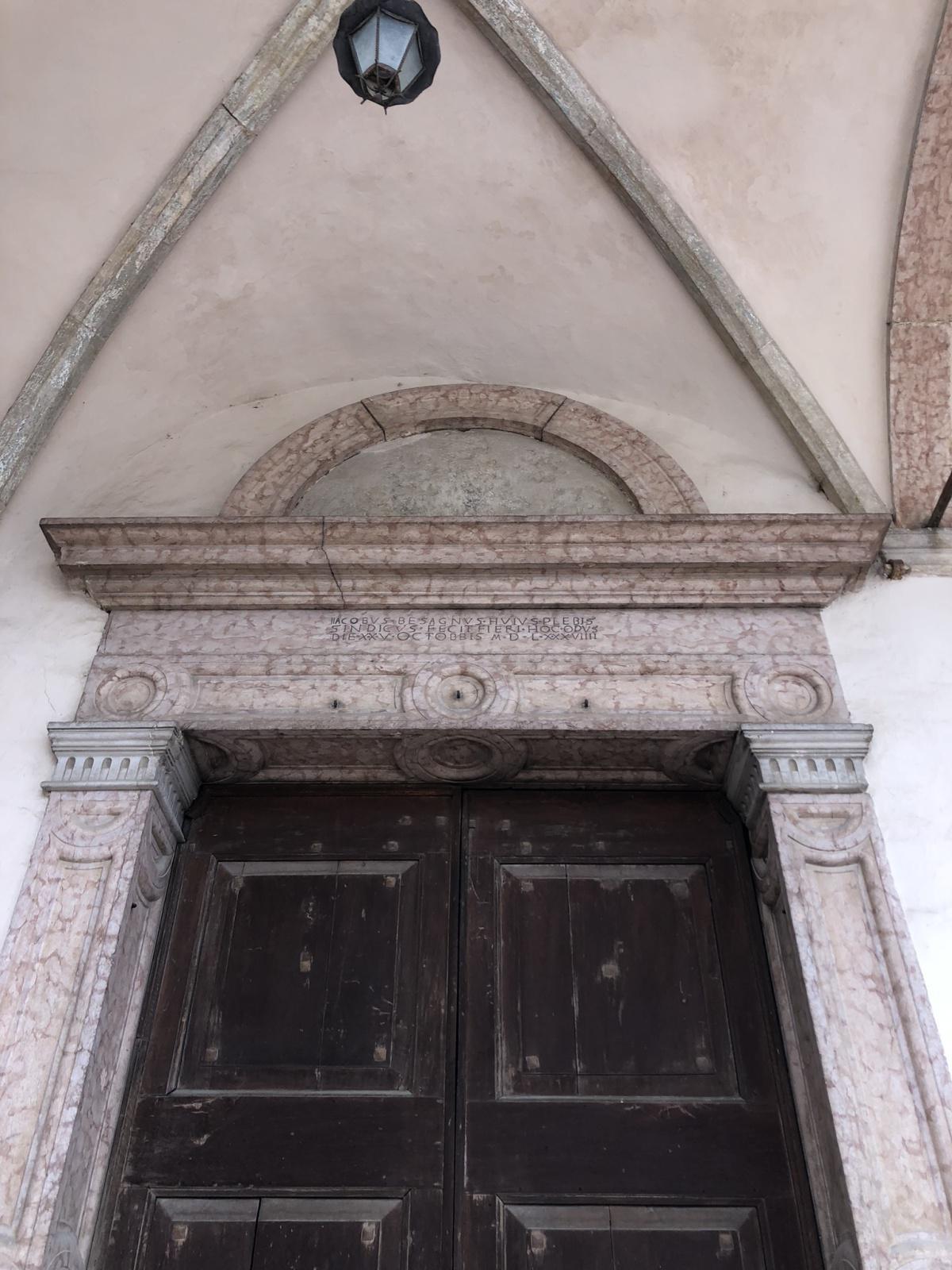
Chiesa di Santa Maria Assunta
Piazza Maria Assunta, Calavino, Madruzzo
IT
La chiesa di Santa Maria Assunta, risalente all’XI secolo, è la parrocchiale di Calavino, frazione del comune di Madruzzo.
La prima chiesa fondata a Calavino risale all’XI secolo e le prime testimonianze documentarie risalgono al 1236, anno della sua prima ricostruzione. Durante la prima metà del XVI secolo la famiglia Madruzzo decide la sua riedificazione e l’ampliamento riguarda la navata che viene sopraelevata e anche il presbiterio. Anche la facciata cambia aspetto con un nuovo pronao davanti al portale principale. Il portale laterale viene arricchito con un protiro. Oltra a questi lavori anche la parte presbiteriale è ampliata e viene edificata la cappella laterale dedicata alla famiglia Madruzzo. La cappella della famiglia Madruzzo è arricchita da affreschi attribuiti a Marcello Fogolino.
La cappella dedicata al Rosario è costruita nella seconda metà del XVII secolo e viene affrescata ed arricchita di stucchi e tele. Due grandi finestre nella zona del presbiterio vengono murate un secolo più tardi. Nel 1867 altre due grandi finestre, poste sulla parete a sud, sono ridotte a lunette.
Sigismondo Nardi decora il presbiterio all’inizio del XX secolo.
Negli anni settanta l’edificio è ritinteggiato e i vari affreschi presbiteriali sono restaurati. Gli ultimi interventi conservativi sono del 1993, quando si restaurarono molte decorazioni a stucco, ad affresco o in tele.
La facciata della chiesa ha un pronao in stile rinascimentale appoggiato alla parete e in alto un timpano classicheggiante. Lateralmente si trova la torre campanaria. L’affresco riportato in luce durante i lavori nella seconda metà del XX secolo rappresenta la Madonna con San Cristoforo. I ritratti ad affresco di membri della famiglia Madruzzo nella cappella a loro dedicata vengono attribuiti da alcuni a Tiziano Vecellio.
EN
The Church of Santa Maria Assunta, dating back to the 11th century, is the parish church of Calavino, a hamlet of the municipality of Madruzzo.
The first church founded in Calavino dates back to the 11th century and the first documentary evidence dates back to 1236, the year of its first reconstruction. During the first half of the 16th century, the Madruzzo family decided on its rebuilding and the extension concerned the nave, which was raised and also the presbytery. The façade also changes appearance with a new pronaos in front of the main portal. The side portal is enriched with a porch. In addition to these works, the presbytery is also extended and the side chapel dedicated to the Madruzzo family is built. The Madruzzo family chapel is enriched with frescoes attributed to Marcello Fogolino.
The chapel dedicated to the Rosary is built in the second half of the 17th century and is frescoed and enriched with stuccoes and paintings. Two large windows in the presbytery area were walled up a century later. In 1867, two more large windows on the south wall were reduced to lunettes.
Sigismondo Nardi decorated the presbytery at the beginning of the 20th century.
In the 1970s, the building was repainted and the various presbytery frescoes were restored. The most recent conservation work dates back to 1993, when many stucco, fresco and canvas decorations were restored.
The church façade has a Renaissance-style pronaos leaning against the wall and a classical gable at the top. To the side is the bell tower. The fresco brought to light during work in the second half of the 20th century depicts the Madonna with St. Christopher. The fresco portraits of members of the Madruzzo family in the chapel dedicated to them are attributed by some to Titian Vecellio.
DE
Die aus dem 11. Jahrhundert stammende Kirche Santa Maria Assunta ist die Pfarrkirche von Calavino, einem Ortsteil der Gemeinde Madruzzo.
Die erste Kirchengründung in Calavino geht auf das 11. Jahrhundert zurück und die erste urkundliche Erwähnung stammt aus dem Jahr 1236, dem Jahr des ersten Umbaus. In der ersten Hälfte des 16. Jahrhunderts beschloss die Familie Madruzzo den Wiederaufbau und die Erweiterung betraf das Kirchenschiff, das erhöht wurde, sowie das Presbyterium. Auch die Fassade verändert ihr Aussehen mit einem neuen Vorbau vor dem Hauptportal. Das Seitenportal wird durch eine Vorhalle bereichert. Neben diesen Arbeiten wird auch das Presbyterium erweitert und die Seitenkapelle für die Familie Madruzzo errichtet. Die Kapelle der Familie Madruzzo wird mit Fresken bereichert, die Marcello Fogolino zugeschrieben werden.
Die dem Rosenkranz gewidmete Kapelle wird in der zweiten Hälfte des 17. Jahrhunderts erbaut und mit Fresken, Stuck und Gemälden verziert. Zwei große Fenster im Bereich des Presbyteriums wurden ein Jahrhundert später zugemauert. Im Jahr 1867 wurden zwei weitere große Fenster an der Südwand zu Lünetten verkleinert.
Sigismondo Nardi dekorierte das Presbyterium zu Beginn des 20. Jahrhunderts.
In den 1970er Jahren wurde das Gebäude neu gestrichen und die verschiedenen Fresken des Presbyteriums wurden restauriert. Die jüngsten Restaurierungsarbeiten stammen aus dem Jahr 1993, als zahlreiche Stuck-, Fresken- und Leinwanddekorationen restauriert wurden.
Die Fassade der Kirche besteht aus einem an die Wand gelehnten Pronaos im Renaissance-Stil und einem klassizistischen Giebel an der Spitze. An der Seite befindet sich der Glockenturm. Das Fresko, das bei den Arbeiten in der zweiten Hälfte des 20. Jahrhunderts freigelegt wurde, stellt die Madonna mit dem heiligen Christophorus dar. Die Freskenporträts der Mitglieder der Familie Madruzzo in der ihnen gewidmeten Kapelle werden von einigen dem Tizian Vecellio zugeschrieben.
